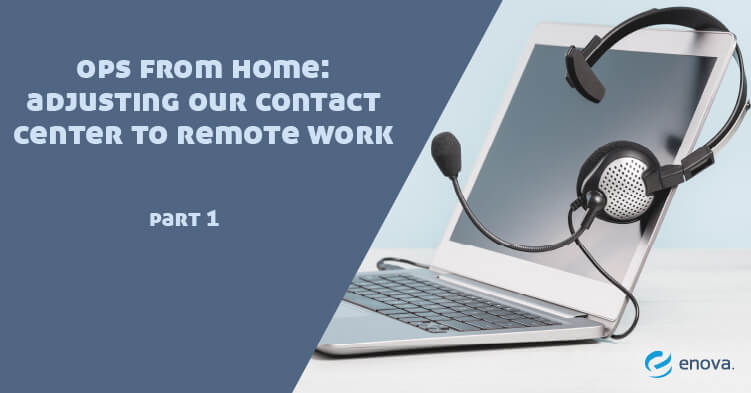Adjusting Our Contact Center to Remote Work: Part 1

By Jason Such
This is the first of a two part series where we look back on how we planned and transitioned our workforce to a remote work state along with shifting priorities and the way we drove performance to support Enova’s COVID-19 Response Strategy in 2020. In Part 1, we share how we planned to move our teams to a remote work state and the areas of focus through that process. In Part 2, we dig into how we pivoted our strategy, adjusted our priorities and shifted our workforce to new functions to support Enova’s COVID-19 response strategy.
In early March 2020, we started to hear concerns throughout the world of a virus that could jeopardize our ability to work in person. We started to do what we do best, plan for the “what if” and be prepared for anything. We didn’t have a plan set up for this exact scenario, so we definitely had to pivot. I was asked to be the Person in Charge (PIC) for our Operations team for this initiative. The first thing I did was create a project plan that included all of the major areas of focus: technical capabilities, people, communications, and our initial business strategy.
As I look back on the previous year, it’s important to highlight that the key to our success was our team. We have over 600 team members in our contact centers, and we’ve never had one representative work remote, let alone the entire organization. Our IT, Communications, People, and Training teams all did a great job coming together to support our transition to remote work. Our contact center leadership staff did a fantastic job aiding the transition and their teams to ensure we were there for our customers, while our representatives did a wonderful job asking questions and being ready for whatever came their way. Supporting our customers was our number one goal, and the entire team was there when our customers needed us most.
First, we had to find a way that a remote work state could function. By using Amazon Workspaces (AWS), our IT team found a secure way to have our front line associates access what they needed and for them to have an easy way to communicate with our customers from home. They also made sure we had enough hardware for those that needed it by ordering laptops and securing monitors, cables and anything else needed to ensure a smooth transition. The team created Slack channels and G-chat rooms for easy communication with our teams during the initial transition to remote work.
Once we had a way to work from home, we needed to start testing and creating a phased approach for the remote transition. We have a number of different functions and teams, each needed to be tested to ensure that the different CRMs(customer relationship management Tools) or operations performed well under the new working conditions. Once that was complete, we started phasing our team to remote work over a 5 day period. Our initial plan called for a longer transition time, but the world was changing by the day, so we did too.
Communication was key during this process. Anytime you are communicating with a large population that is spread out across four different sites, your communication has to be buttoned up and clear. We had our normal types of communication — emails, in-person round ups — but also came up with creative contingency plans like blast dialing in case we needed to communicate updates to the team in a quick way. Blast dialing is an automatic message delivered to all our team members via phone. We didn’t end up leveraging this process but it was better to be safe than sorry. We also needed to make sure that the software instructions, scripting for our customer calls and FAQ’s were readily available for our teams to make the transition as smooth as possible. We were able to leverage our internal WIKI to house this information, and it was easily accessed through AWS. We also had to keep building on the initial remote tools based on questions that came up internally and from our customers, along with troubleshooting tips for the new set ups for our team.
Finally, in transitioning to a remote work state, policies needed to change. Our Time and Attendance team needed to create a new way for our team members to track their time, and we needed to be flexible for associates that were having challenges transitioning to remote work. Our People team created a remote work policy and updated processes around coaching and career development.
(To be continued in Part II…)